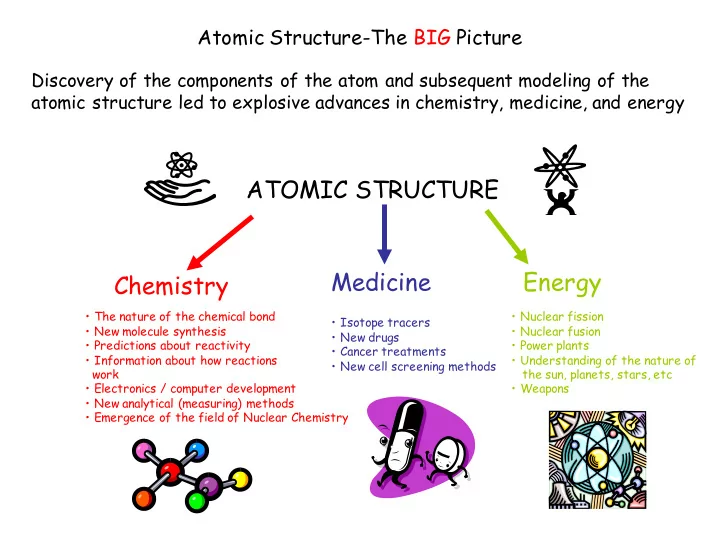

Atomic Structure-The BIG Picture Discovery of the components of the atom and subsequent modeling of the atomic structure led to explosive advances in chemistry, medicine, and energy ATOMIC STRUCTURE Medicine Energy Chemistry • The nature of the chemical bond • Nuclear fission • Isotope tracers • New molecule synthesis • Nuclear fusion • New drugs • Predictions about reactivity • Power plants • Cancer treatments • Information about how reactions • Understanding of the nature of • New cell screening methods work the sun, planets, stars, etc • Electronics / computer development • Weapons • New analytical (measuring) methods • Emergence of the field of Nuclear Chemistry
Progression of the Atomic Model…Discovery of the electron “Plums” or “pudding” WIkipedia J.J. Thomson in Philosophical Magazine, 1904 Thomson’s “Plum Pudding” Model • He discovered the electron (link) in 1897 before “... the atoms of the elements consist of a number the nucleus was discovered of negatively electrified corpuscles enclosed in a • Later discoveries invalidated this model sphere of uniform positive electrification, ... “ Millikan animation Millikan later determined the mass and charge of the electron: Charge: 1.602 176 53(14) x 10 − 19 coulomb Mass: 9.10938188 × 10 -31 kilograms , about 1/1840 of a proton
Refining the atomic model Rutherford’s famous gold foil experiment: • showed that the positive charge of the atom MUST be concentrated in a tiny, yet heavy volume he called the nucleus • almost ALL of the mass of the atom is in the nucleus • very lignt electrons surround this nucleus • the volume that an atom occupies is mostly empty space Gold foil animation If a nucleus were as big as you are wide, the edge of its atom (outermost electron orbital) would be over a mile away! About 1.25 miles .
Further refinement of the model • What’s in an atomic nucleus? – Protons-discovered by Rutherford • Positively charged 1.60217653 × 10 − 19 Coulomb • A diameter of about 1.65 × 10 − 15 m • Mass of 1.6726 × 10 − 27 kg • About 1840 times the mass of an electron – Neutrons-discovered by Chadwick in 1932 • Not charged • A diameter of about 1.65 × 10 − 15 m • Mass of 1.6749 x 10 -27 kg
Current model of the atom Led to the current model Lots of empty space ! Bohr Model • electrons in well defined “planetary” orbits • overall spherical shape or paths around the nucleus • electrons occupy certain orbital volumes or • still good for visualizing the energy transitions clouds of electrons • the type of cloud it occupies depends upon its energy or distance from the nucleus http://education.jlab.org/qa/atom_model_04.gif http://www.mhhe.com/physsci/astronomy/fix/student/images/16f07.jpg
Atomic number and Mass number # of protons + # neutrons = mass number A carbon atom with 6 protons and 6 neutrons has a mass number = 12 # of protons = atomic number The atomic number of carbon is 6. Number of electrons will equal the number of protons for an atom with NO NET CHARGE
Isotopes and Atomic Mass What’s the difference between MASS NUMBER and ATOMIC MASS? It turns out that atoms OF THE SAME ELEMENT may exist as ISOTOPES. ISOTOPE • an atom with the same atomic number (same number of protons) but a different number of neutrons • isotopes of the same atom have approximately the same chemical properties Mass number 12 C Symbolizing isotopes: C-12 or Chemical 6 symbol protons The ATOMIC MASS is a weighted average of the mass for each isotope http://earthguide.ucsd.edu/virtualmuseum/images/ThreeCarbonIsotopes.jpg
Atomic Mass • The amu (atomic mass unit) is the unit used to express the mass of an atom. 1 amu = 1/12 of the mass of the C-12 isotope of carbon 1 amu = 1.66053886 × 10 -24 grams The mass of 1 proton or 1 neutron is approximately 1 amu. Carbon-12 makes up 98.89% of naturally-occurring carbon. Carbon-13 makes up 1.11% of naturally occurring carbon. Use this information to determine the average atomic mass of carbon. (12amu)(.9889) + (13 amu)(.0111) = 12.0111 amu
Atomic Charge and IONS • Atoms in elements are not charged because the number of protons = the number of electrons • When an atom GAINS one or more electrons, it becomes NEGATIVELY charged because it now holds more electrons than protons • When an atom LOSES one or more electrons, it becomes POSITIVELY charged because it now holds fewer electrons than protons • IONS are charged atoms. A CATION is positively charged. An ANION is negatively charged.
Recommend
More recommend